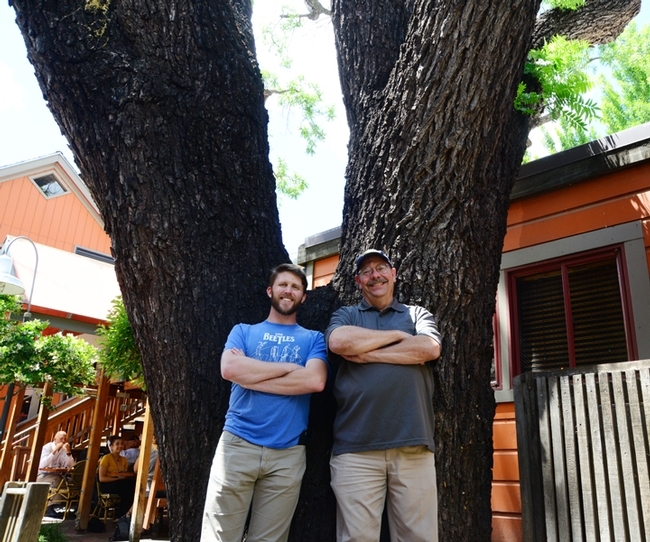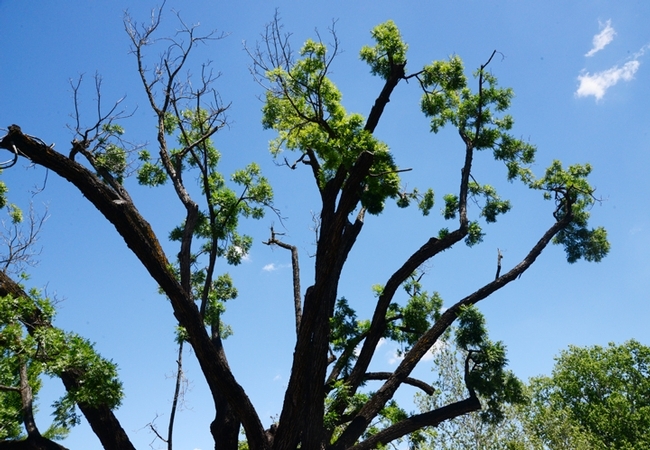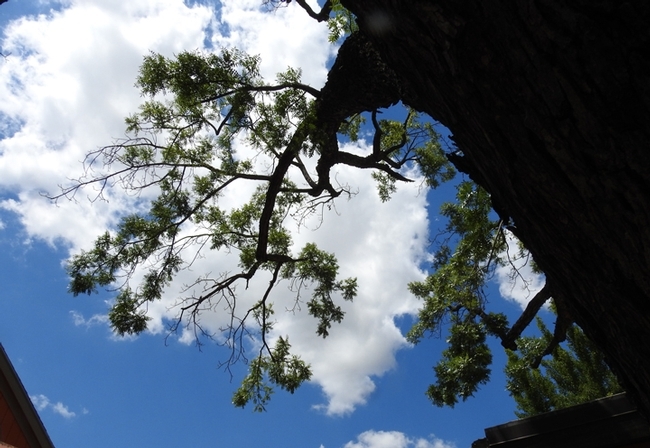- Author: Kathy Keatley Garvey
Gotta love that Gray Hairstreak.
If you don't like putting "gray" and "hair" in the same sentence, not to worry.
This is the butterfly, Strymon melinus.
When the it's hanging around a Mexican sunflower, Tithonia rotundifola, the orange spots on its tail accent the color of the flower.
"Adults visit an immense variety of flowers, both wild and cultivated," writes Art Shapiro, UC Davis distinguished professor of evolution and ecology on his website. "They are particularly addicted to Heliotrope and white-flowered Apiaceae."
"This is one of the most polyphagous butterflies known, recorded on host plants in many families. Its most frequent hosts in our area are mallows, including the weedy species of Malva; legumes, including Spanish Lotus (Lotus purshianus), Bird's-Foot Trefoil (Lotus corniculatus), White Clover (Trifolium repens) in lawns, Alfalfa (Medicago sativa) and many others;and Turkey Mullein (Eremocarpus or Croton setigerus, Euphorbiaceae)."
The Gray Hairstreak is considered a weedy butterfly. "Weedy," as Shapiro explains on his web site, "is a general term for organisms that are typically associated with habitats that are disturbed by human activities or are dominated by non-native, invasive plants."
At first glance, you don't know "which end is up"--which makes it all the better for the butterfly to escape predators.
This one allowed me to get quite close. It was more interested in the nectar than the slow movement of the long lens.
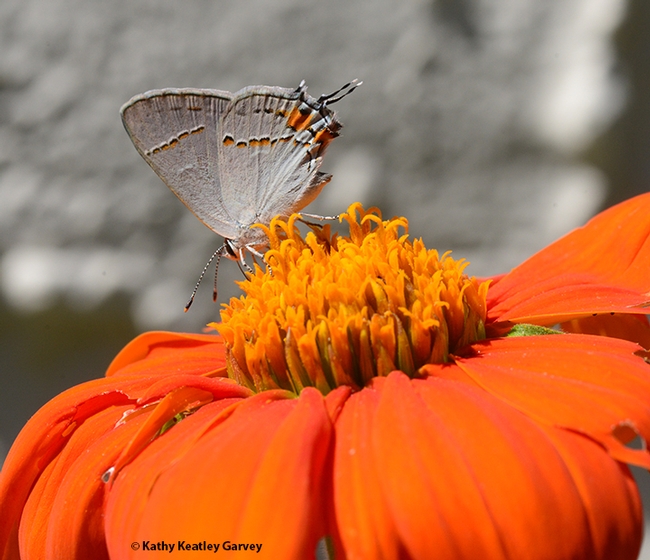
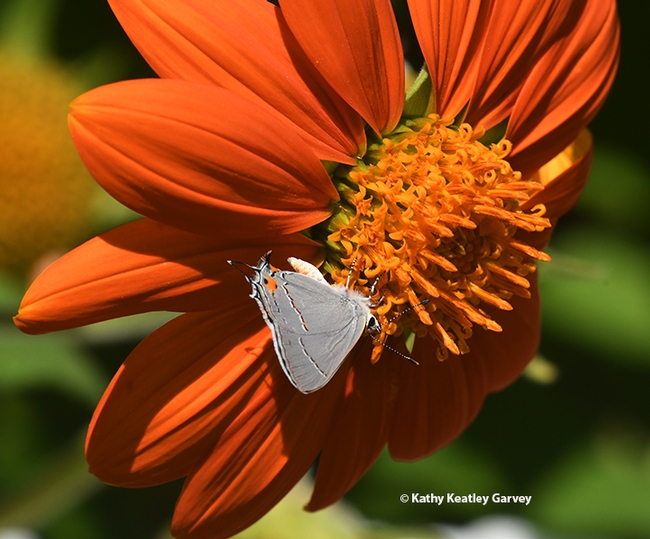
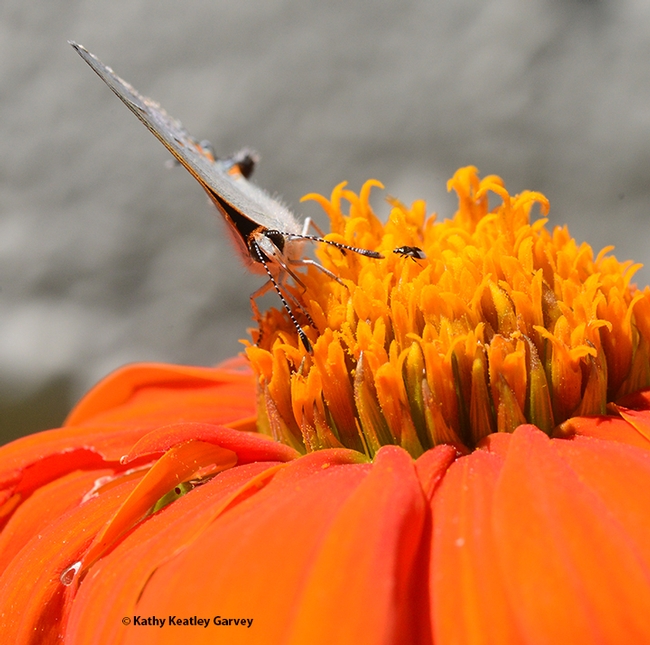
- Author: Kathy Keatley Garvey

We don't normally name the monarch butterflies we rear, but we decided that the first one reared from an egg "The Greg Way" would be named for Greg--naturalist Greg Kareofelas, associate at the Bohart Museum of Entomology, UC Davis.
The first one, however, is a girl, so she's "Greta" instead of "Greg."
Over the last five years, we've reared more than hundred monarchs from caterpillar to chrysalis to adult. We collect the 'cats from the three species of milkweed in our Vacaville pollinator garden. This summer, however, we decided to collect a few eggs after seeing Mama Monarchs depositing them on tropical milkweed, Asclepias curassavica, and narrowleaf milkweed, Asclepias fascicularis. (As recommended, we cut back the tropical milkweed before the migratory season begins.)
Here's "The Greg Way":
"I put a single egg on its leaf in a small salsa container (the little plastic ones you would get at a Mexican restaurant)," Kareofelas says. "I take a square of toilet paper and fold it into a small square (3/4 of inch), dampen it and squeeze it so it is not sopping wet, just damp, and set the leaf and egg on the top. Put the lid tightly on the container. This keeps a level of moisture in the container. I check the containers daily, changing the toilet paper square to keep from molding."
The egg hatched. The caterpillar ate. And ate again, again and again. Did we mention "Again?" Again, again and again. She went through five instars, and then she j'd and formed a chrysalis on the ceiling of our indoor, netted butterfly habitat. The entire cycle from egg to larva to chrysalis to adult takes about a month. (See more on Bug Squad blog, Joy of Rearing Monarchs)
So Greta eclosed this morning, big, bold and beautiful. We released her in the pollinator garden, near where Mama deposited her as an egg. Greta inched up on a Mexican sunflower (Tithonia rotundiflora) and then took flight. A blur.
Hopefully, she will mate and overwinter in coastal California, avoiding the wildfires, adverse weather conditions and predators.
Safe travels, Greta! (And thank you, Greg!)
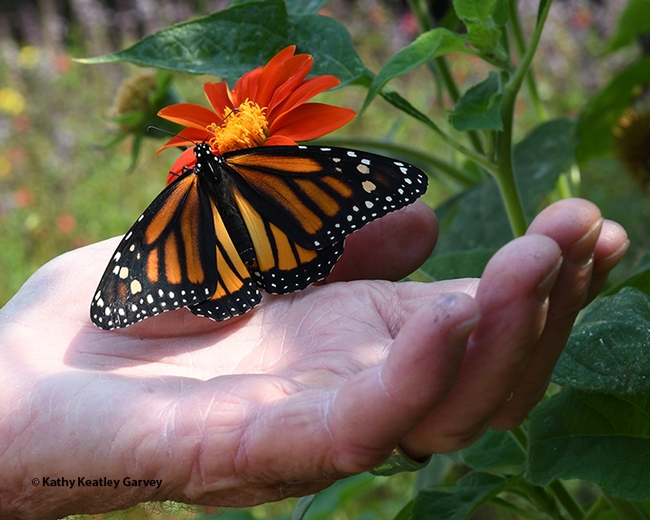
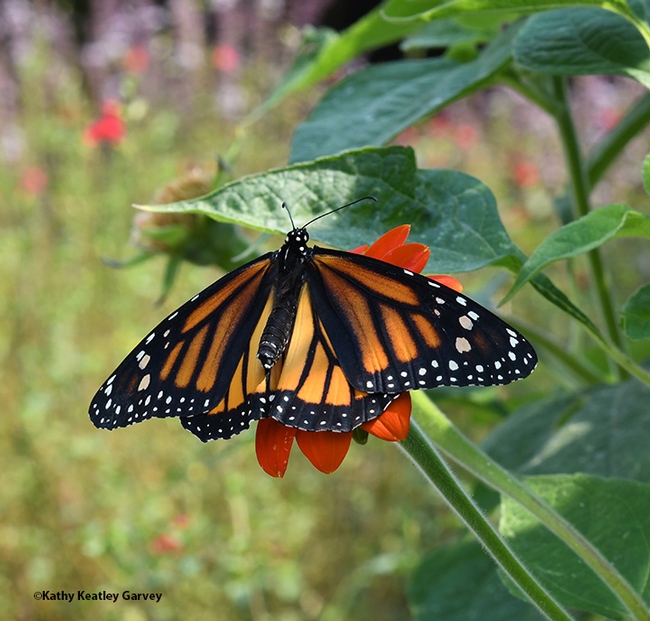
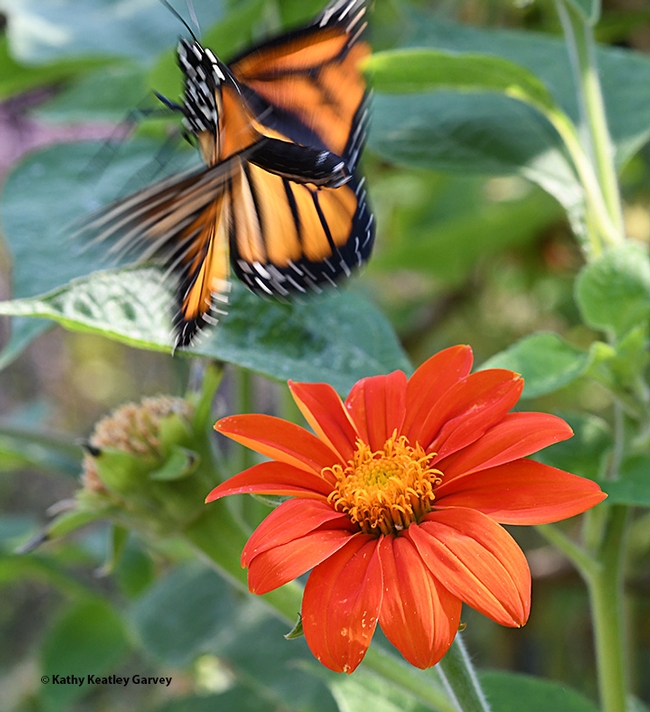
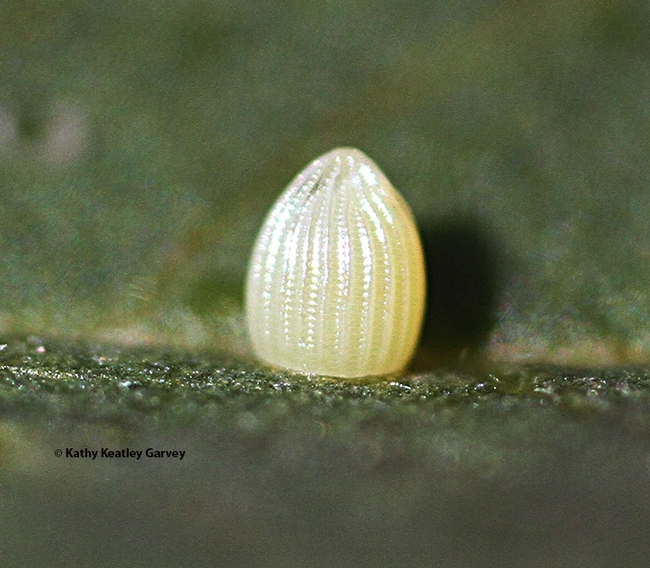
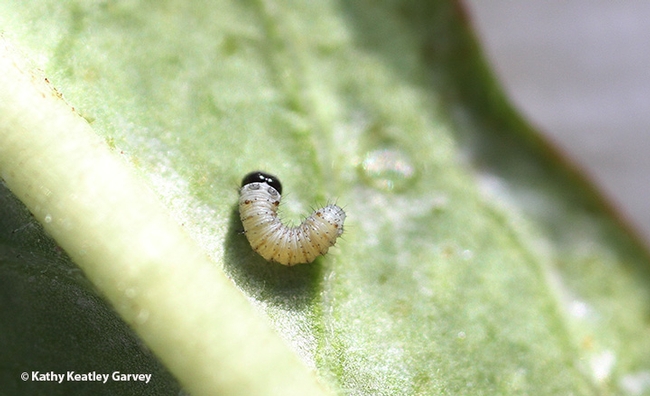
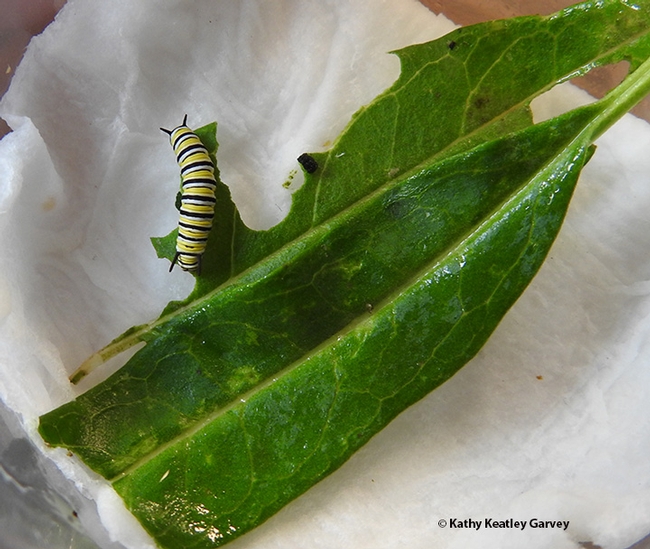
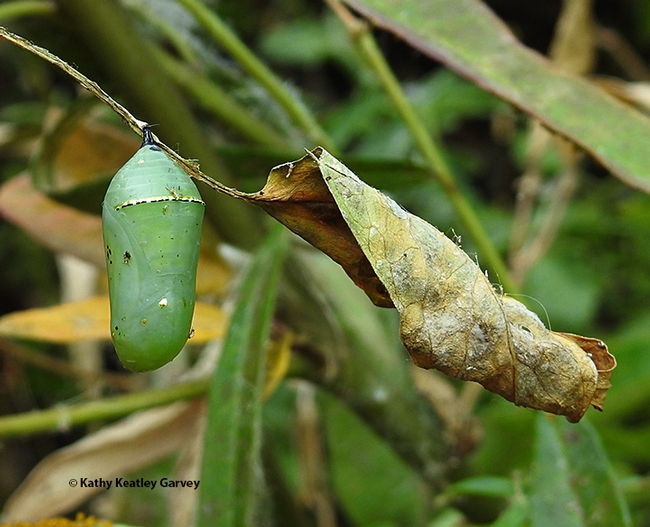
- Author: Kathy Keatley Garvey
It's always a good day when you encounter a dragonfly on Main Street USA.
Such was the case on Wednesday, July 17 when seemingly out of nowhere, a shiny Tramea lacerata "black saddlebags" appeared in front of me on the sidewalk fronting the Vacaville Chamber of Commerce.
Its habitat is near ponds, lakes, ditches, slow streams, or other bodies of water, but there it was.
"It is a freshly emerged female, probably on its maiden flight," said naturalist Greg Kareofelas of Davis, an associate with the Bohart Museum of Entomology, University of California, Davis. "This is its most vulnerable time. If it gets through the next day or so, off to fast flying it will go and you will never get close to it again."
I gingerly picked it up and photographed it on a Mexican sunflower (Tithonia). Half an hour later, I witnessed it fly over our fish pond, never to be seen again. At least by me!
This species, found throughout North America, is included in a Bohart Museum's poster, "Dragonflies of California." Designed by Fran Keller (then a doctoral student in entomology at UC Davis and now an assistant professor at Folsom Lake College), with images by Kareofelas, the poster is available in the Bohart Museum's gift shop in Room 1124 of the Academic Surge Building on Crocker Lane, UC Davis campus.
The black saddlebags dragonfly belongs to the Order Odonata (dragonflies and damselflies), suborder Anisoptera (dragonflies) family Libellulidae (skimmers), genus Tramea (saddlebags) and species lacerata (black saddlebags). "It flies constantly, often gliding, perches infrequently," according to BugGuide.net. The University of Michigan biokids website yields more information.
It's easily distinguishable. Says Wikipedia: "It has distinctive wings with characteristic black blotches" at its proximal ends, "which make the dragonfly look as though it is wearing saddlebags. The black saddlebags is a relatively large dragonfly at about 5 centimeters in length. The body is thin and black, and the female may have lighter spotting or mottling dorsally. The head is much wider than the rest of the body and is dark brown in color...Some populations of this dragonfly undertake migrations. Both the larvae and adult forms are efficient predators of mosquitoes so they are a helpful insect to have in wet areas where mosquito infestations occur." A wonderful predator...
Of predators, sidewalks and black saddlebags...
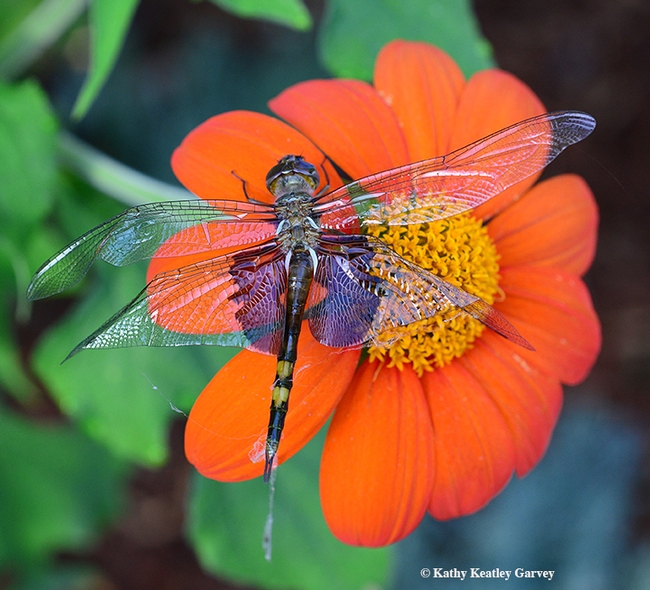
- Author: Kathy Keatley Garvey
What a show!
Last weekend we spotted female European wool carder bees (so named because they collect or card plant hairs for their nests) buzzing in and out of our snapdragons.
The bees, about the size of honey bees, are mostly black and yellow. The females range in body length from 11 to 13 millimeters, while the males are 14 to 17 mm.
The males are very territorial. As we mentioned in a previous Bug Squad blog, they put the "terror" in territorial. The males bodyslam other insects, as they try to protect their turf, per chance to mate with the females. We've seen the males terrorize the much larger Valley carpenter bees--bodyslamming them, dislodging them and chasing them away.
The European wool carder bees, Anthidium manicatum, are natives of Europe. Their "immigrant ancestor" was first detected in the United States (New York) in 1963, and the species spread west. It was first recorded in California (Sunnyvale) in 2007.
The bee, according to research entomologist Tom Zavortink of the Bohart Museum of Entomology at UC Davis, was accidentally introduced into New York state. It was not purposefully introduced to pollinate alfalfa, as some reports allege, he said.
Writing in a 2008 edition of the Pan-Pacific Entomologist, Zavortink and fellow entomologist Sandra Shanks, now of Port Townsend, Wash., pointed out that several papers “have documented its spread from neighboring areas in the northeastern United States and southern Canada” and that the species has since crossed the country. It was confirmed in Colorado in 2005, Missouri in 2006, and Maine, Michigan, Maryland and California (Sunnyvale) in 2007, the entomologists wrote. Records show it was first collected in Davis on July 26, 2007.
It was well established in the Central Valley by 2008, according to Lynn Kimsey, director of the Bohart Museum of Entomology and UC Davis professor of entomology.
In Vacaville, we first encountered the European wool carder bee in the spring of 2010.
Its plant preferences include lamb's ear (Stachys byzantine, in the mint family Lamiaceae), a perennial grown for its fuzzy, silvery gray-green foliage. It's also been collected in the figwort/snapdragon family (Scrophulariacae) and the pea and bean family (Fabaceae), according to the Zavortink-Shanks research.
Usually the European wool carder bees are hanging around our foxgloves and catmint (neither is blooming yet) and our lavender (blooming but being ignored).
But snapdragons? We've never seen them foraging on snapdragons (Antirrhinum) until now. That's because we've never planted snapdragons until this spring!
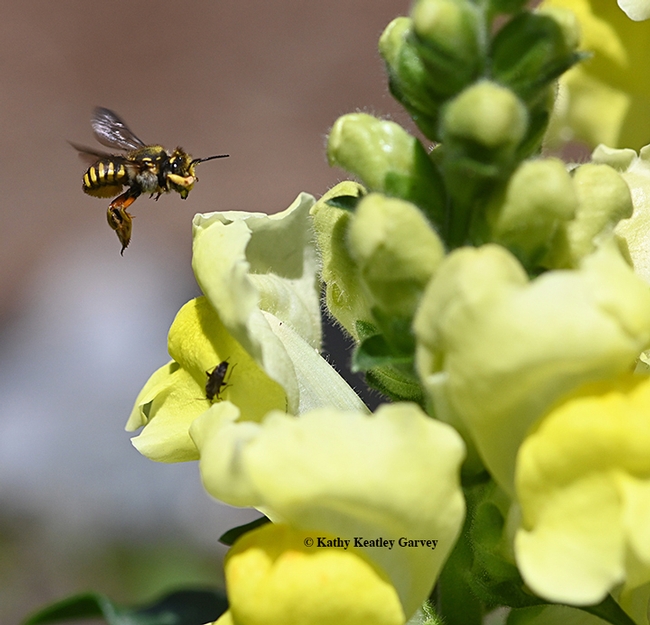
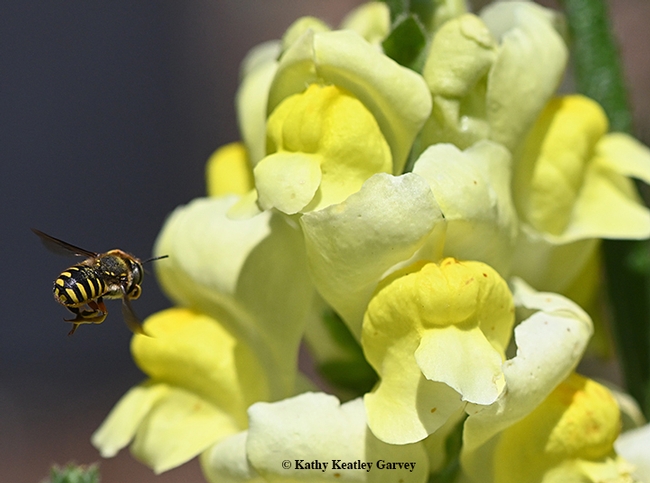
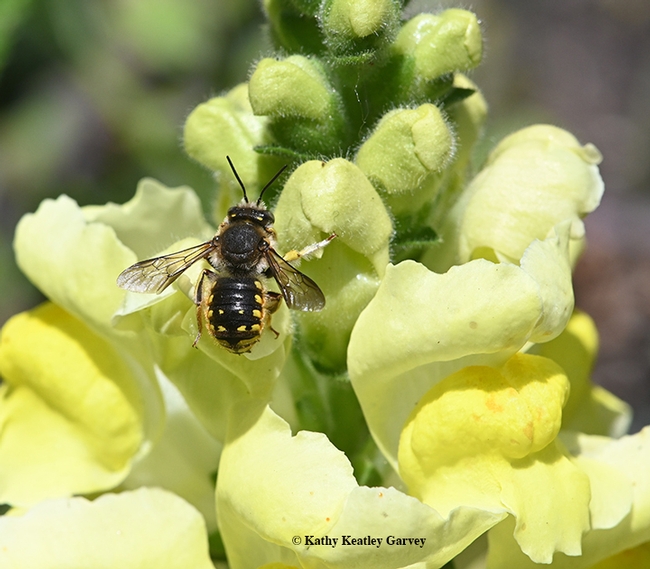
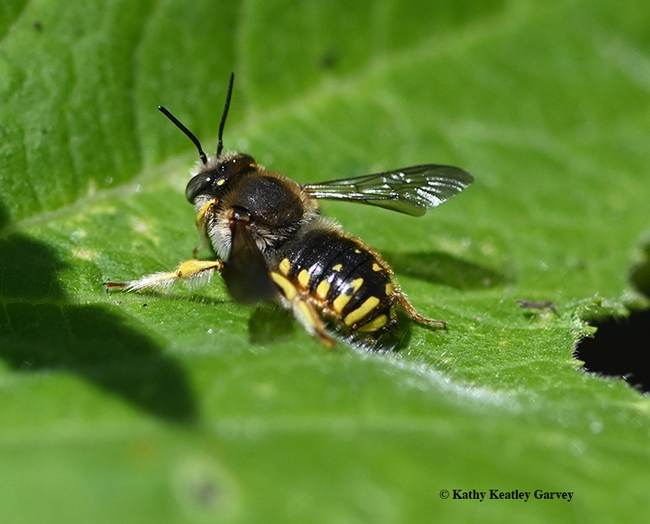
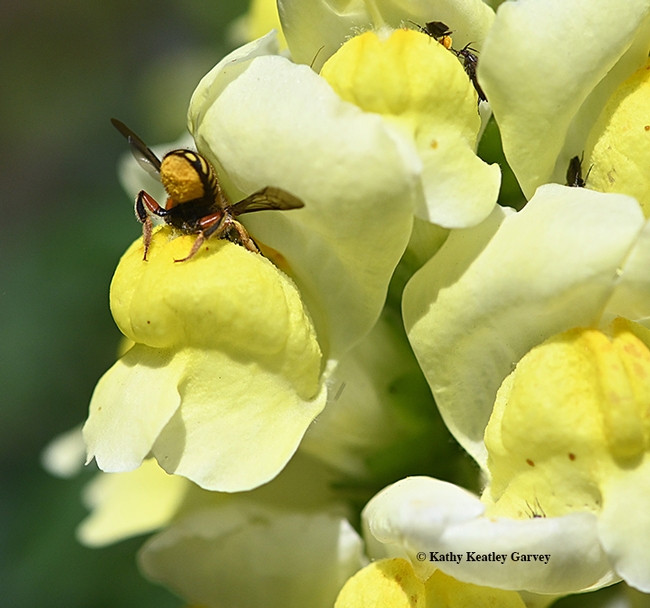
- Author: Kathy Keatley Garvey
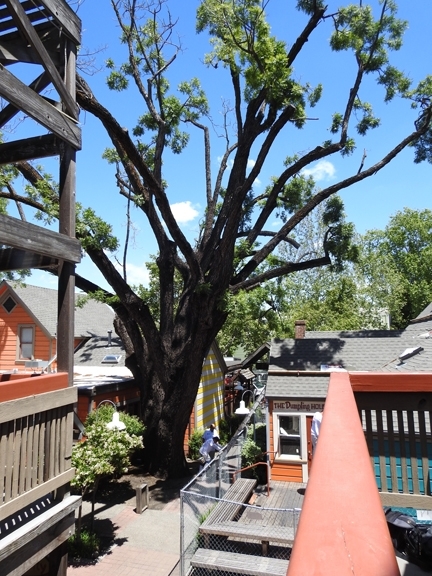
It's about 150 years old, 50 feet in height, and measures about five feet in diameter. And it's dying.
What's killing it is thousand cankers disease (TCD), an emerging insect-fungus complex.
It's killing a lot of black walnut trees.
In fact, TCD has caused profound damage to black walnut trees not only in urban areas of California and other western states, but in Pennsylvania, Tennessee and Virginia, according to a newly published review by UC Davis-affiliated scientists and their colleagues.
The article, “Status and Impact of Walnut Twig Beetle in Urban Forest, Orchard and Native Forest Ecosystems,” published in the Journal of Forestry, updates the spread of the disease, and chronicles the role of the bark beetle, Pityophthorus juglandis, and the canker-producing fungus, Geosmithia morbida, in killing walnut trees, especially black walnuts.
Native to southwestern United States and northern Mexico, the bark beetle, about half the size of a grain of rice, “has invaded urban, orchard and native forest habitats throughout the United States, as well as Italy,” said lead author and forest entomologist Steven Seybold of the Pacific Southwest Research Station, USDA Forest Service, Davis, and a lecturer and researcher with the UC Davis Department of Entomology and Nematology.
Walnut twig beetles (WTB) tunnel into branches and trunks of walnut (Juglans) where they create galleries for mating and reproduction. They carry spores of the fungus into their galleries, and the resulting fungal infection causes formation of cankers, which coalesce and girdle branches and stems.
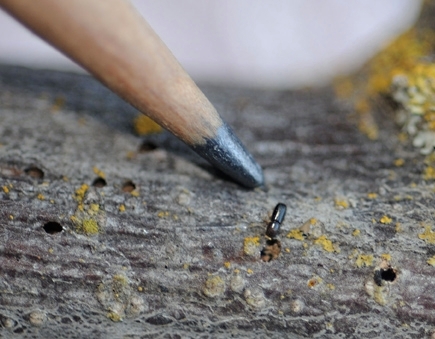
“The walnut twig beetle is a significant pest of very large trees because it sequentially attacks the small branches--though ironically not the twigs--all the way down the trunk to the soil line,” said Seybold, a pioneering scientist of TCD, who first found TCD evidence in Davis in 2008. “Most bark beetle species are not this thorough in using all of the phloem tissue in their plant hosts. In Davis right now, in the courtyard next to Sophia's Thai Restaurant, 129 E St, the tiny beetle is gradually killing the largest northern California black walnut tree in the city. It has taken nearly a decade, but the crown of the massive tree is nearly completed killed.”
Seybold estimated that the E Street tree is about 150 years old, "maybe older." It measures almost 65 inches or just over five feet.


Seybold noted that the disease is “unique because of its multifaceted negative impact on walnut trees involved in landscaping, food production, and forestry. Walnut trees are valuable ecologically and for food and timber, so the walnut twig beetle is a good model in which to study the impact of a bark beetle on forest and agro-ecosystem services.”
The five co-authors of the synthesis article include Stacy Hishinuma and Andrew Graves, two USDA forest entomologists with UC Davis connections. Hishinuma, who works in the Pacific Southwest Region, San Bernardino, and holds a doctorate in entomology from UC Davis, studied in the Seybold and Mary Lou Flint labs, UC Davis Department of Entomology and Nematology. Graves, who works in the Southwestern Region, Albuquerque, N.M., is a former postdoctoral fellow in the UC Davis Department of Plant Pathology.
Other co-authors are Professor William Klingeman III of the Department of Plant Sciences, University of Tennessee, and forest entomologist Tom Coleman with the USDA Forest Service's Southern Region, Asheville, N.C..
UC Davis doctoral student Jackson Audley of the Seybold lab and Richard Bostock lab (Plant Pathology), contributed photos of dead and dying walnut trees in the Davis area, along with UC Davis doctoral student Corwin Parker and Hishinuma. Audley, who is researching an ensemble of behavioral chemicals that repel the walnut twig beetle from landing on English walnut trees, conducts his research in a commercial orchard near Winters.
“WTB is one of a few invasive bark beetles in North America where expanding distribution and impact have been pronounced enough to affect other species, communities, and ecosystems to the extent that services provided by urban forests, agroecosystems, and wildland areas have been altered,” the co-authors concluded in their paper. “We envision that ecological impacts of WTB will continue to unfold across a wider geographic area to affect various types of key services, i.e., provisioning (e.g., timber and nontimber products); regulating (e.g., air and water quality/quantity, climate regulation); and cultural (e.g., recreation, aesthetics, shade) services.”
Scientists first collected the beetle in North America in 1896 in New Mexico, 1907 in Arizona, 1959 in California, and 1960 in Mexico, but never considered it a major pest of walnut trees until black walnuts began deteriorating and dying in New Mexico in the early 2000s. Walnut tree mortality that occurred in the early 1990s in the Wasatch Mountains of Utah and in the Willamette Valley of Oregon is now attributed to TCD.
“Currently, good cultural practices and sanitation of infested materials are the primary strategies for disease management within orchards and also for prevention of spread of the disease and vector to regions with low rates of infection,” according to the UC Statewide Integrated Pest Management Program (UC IPM)>
UC IPM recommends that trees with less than 50 percent live crown be removed to reduce the buildup of walnut twig beetles and inoculum in the trunk and larger scaffold branches. "Chemical control with either fungicides or insecticides is not recommended for management of thousand cankers disease," UC IPM says.
Which brings us back to the massive black walnut tree that is dying on E Street in Davis. If it dates back to 1868, that's the year the city of Davis was founded. Its namesake, Jerome C. Davis, owned a stock farm on the site.
Who was in the White House and who was in the California governor's mansion that year? Andrew Johnson and Henry Haight, respectively. That was also the year that trustees founded the University of California in Oakland; Clark Kerr became the first president. And 1868 was the year Memorial Day was first observed in the United States...and when author Louisa May Alcott published the first volume of her coming-of-age novel, Little Women.
The little tree in Davis became of age, too, growing into a giant tree offering shade, shelter and sustenance. Who would have thought that a tiny insect, half the size of a grain of rice, would play a major role in its demise?
